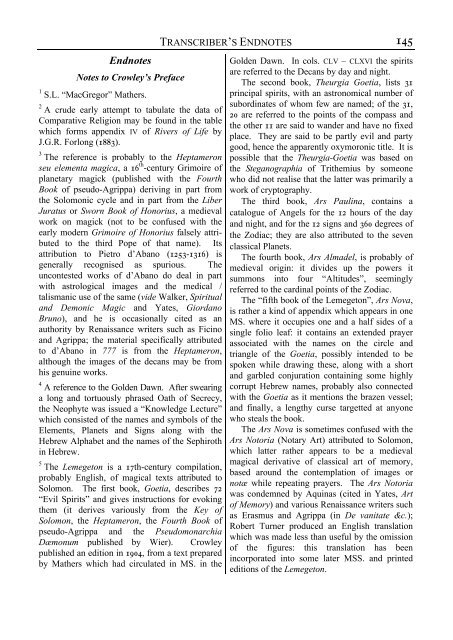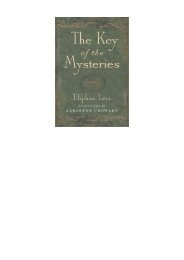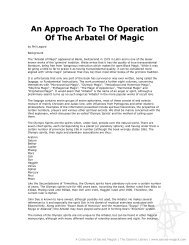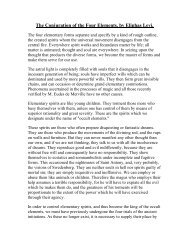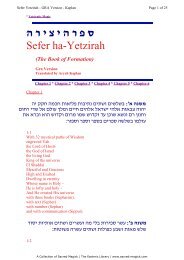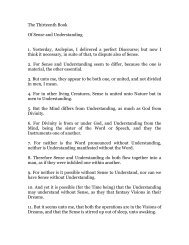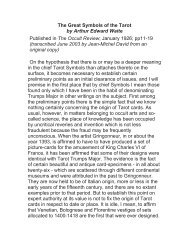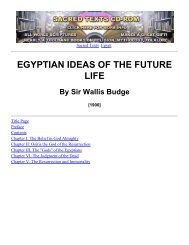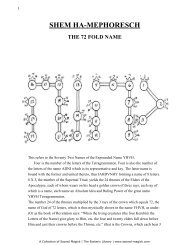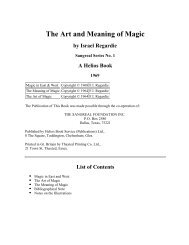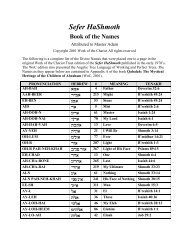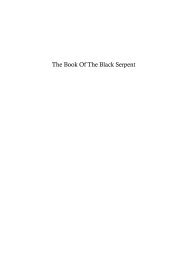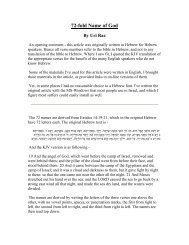Liber 777 (revised) (pdf) - Holy Order of the Golden Dawn Canada
Liber 777 (revised) (pdf) - Holy Order of the Golden Dawn Canada
Liber 777 (revised) (pdf) - Holy Order of the Golden Dawn Canada
You also want an ePaper? Increase the reach of your titles
YUMPU automatically turns print PDFs into web optimized ePapers that Google loves.
Endnotes<br />
Notes to Crowley’s Preface<br />
1 S.L. “MacGregor” Ma<strong>the</strong>rs.<br />
2 A crude early attempt to tabulate <strong>the</strong> data <strong>of</strong><br />
Comparative Religion may be found in <strong>the</strong> table<br />
which forms appendix IV <strong>of</strong> Rivers <strong>of</strong> Life by<br />
J.G.R. Forlong (1883).<br />
TRANSCRIBER’S ENDNOTES<br />
3<br />
The reference is probably to <strong>the</strong> Heptameron<br />
seu elementa magica, a 16 th -century Grimoire <strong>of</strong><br />
planetary magick (published with <strong>the</strong> Fourth<br />
Book <strong>of</strong> pseudo-Agrippa) deriving in part from<br />
<strong>the</strong> Solomonic cycle and in part from <strong>the</strong> <strong>Liber</strong><br />
Juratus or Sworn Book <strong>of</strong> Honorius, a medieval<br />
work on magick (not to be confused with <strong>the</strong><br />
early modern Grimoire <strong>of</strong> Honorius falsely attributed<br />
to <strong>the</strong> third Pope <strong>of</strong> that name). Its<br />
attribution to Pietro d’Abano (1253-1316) is<br />
generally recognised as spurious. The<br />
uncontested works <strong>of</strong> d’Abano do deal in part<br />
with astrological images and <strong>the</strong> medical /<br />
talismanic use <strong>of</strong> <strong>the</strong> same (vide Walker, Spiritual<br />
and Demonic Magic and Yates, Giordano<br />
Bruno), and he is occasionally cited as an<br />
authority by Renaissance writers such as Ficino<br />
and Agrippa; <strong>the</strong> material specifically attributed<br />
to d’Abano in <strong>777</strong> is from <strong>the</strong> Heptameron,<br />
although <strong>the</strong> images <strong>of</strong> <strong>the</strong> decans may be from<br />
his genuine works.<br />
4<br />
A reference to <strong>the</strong> <strong>Golden</strong> <strong>Dawn</strong>. After swearing<br />
a long and tortuously phrased Oath <strong>of</strong> Secrecy,<br />
<strong>the</strong> Neophyte was issued a “Knowledge Lecture”<br />
which consisted <strong>of</strong> <strong>the</strong> names and symbols <strong>of</strong> <strong>the</strong><br />
Elements, Planets and Signs along with <strong>the</strong><br />
Hebrew Alphabet and <strong>the</strong> names <strong>of</strong> <strong>the</strong> Sephiroth<br />
in Hebrew.<br />
5<br />
The Lemegeton is a 17th-century compilation,<br />
probably English, <strong>of</strong> magical texts attributed to<br />
Solomon. The first book, Goetia, describes 72<br />
“Evil Spirits” and gives instructions for evoking<br />
<strong>the</strong>m (it derives variously from <strong>the</strong> Key <strong>of</strong><br />
Solomon, <strong>the</strong> Heptameron, <strong>the</strong> Fourth Book <strong>of</strong><br />
pseudo-Agrippa and <strong>the</strong> Pseudomonarchia<br />
Dæmonum published by Wier). Crowley<br />
published an edition in 1904, from a text prepared<br />
by Ma<strong>the</strong>rs which had circulated in MS. in <strong>the</strong><br />
145<br />
<strong>Golden</strong> <strong>Dawn</strong>. In cols. CLV – CLXVI <strong>the</strong> spirits<br />
are referred to <strong>the</strong> Decans by day and night.<br />
The second book, Theurgia Goetia, lists 31<br />
principal spirits, with an astronomical number <strong>of</strong><br />
subordinates <strong>of</strong> whom few are named; <strong>of</strong> <strong>the</strong> 31,<br />
20 are referred to <strong>the</strong> points <strong>of</strong> <strong>the</strong> compass and<br />
<strong>the</strong> o<strong>the</strong>r 11 are said to wander and have no fixed<br />
place. They are said to be partly evil and party<br />
good, hence <strong>the</strong> apparently oxymoronic title. It is<br />
possible that <strong>the</strong> Theurgia-Goetia was based on<br />
<strong>the</strong> Steganographia <strong>of</strong> Tri<strong>the</strong>mius by someone<br />
who did not realise that <strong>the</strong> latter was primarily a<br />
work <strong>of</strong> cryptography.<br />
The third book, Ars Paulina, contains a<br />
catalogue <strong>of</strong> Angels for <strong>the</strong> 12 hours <strong>of</strong> <strong>the</strong> day<br />
and night, and for <strong>the</strong> 12 signs and 360 degrees <strong>of</strong><br />
<strong>the</strong> Zodiac; <strong>the</strong>y are also attributed to <strong>the</strong> seven<br />
classical Planets.<br />
The fourth book, Ars Almadel, is probably <strong>of</strong><br />
medieval origin: it divides up <strong>the</strong> powers it<br />
summons into four “Altitudes”, seemingly<br />
referred to <strong>the</strong> cardinal points <strong>of</strong> <strong>the</strong> Zodiac.<br />
The “fifth book <strong>of</strong> <strong>the</strong> Lemegeton”, Ars Nova,<br />
is ra<strong>the</strong>r a kind <strong>of</strong> appendix which appears in one<br />
MS. where it occupies one and a half sides <strong>of</strong> a<br />
single folio leaf: it contains an extended prayer<br />
associated with <strong>the</strong> names on <strong>the</strong> circle and<br />
triangle <strong>of</strong> <strong>the</strong> Goetia, possibly intended to be<br />
spoken while drawing <strong>the</strong>se, along with a short<br />
and garbled conjuration containing some highly<br />
corrupt Hebrew names, probably also connected<br />
with <strong>the</strong> Goetia as it mentions <strong>the</strong> brazen vessel;<br />
and finally, a lengthy curse targetted at anyone<br />
who steals <strong>the</strong> book.<br />
The Ars Nova is sometimes confused with <strong>the</strong><br />
Ars Notoria (Notary Art) attributed to Solomon,<br />
which latter ra<strong>the</strong>r appears to be a medieval<br />
magical derivative <strong>of</strong> classical art <strong>of</strong> memory,<br />
based around <strong>the</strong> contemplation <strong>of</strong> images or<br />
notæ while repeating prayers. The Ars Notoria<br />
was condemned by Aquinas (cited in Yates, Art<br />
<strong>of</strong> Memory) and various Renaissance writers such<br />
as Erasmus and Agrippa (in De vanitate &c.);<br />
Robert Turner produced an English translation<br />
which was made less than useful by <strong>the</strong> omission<br />
<strong>of</strong> <strong>the</strong> figures: this translation has been<br />
incorporated into some later MSS. and printed<br />
editions <strong>of</strong> <strong>the</strong> Lemegeton.


